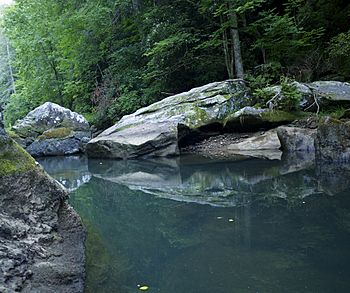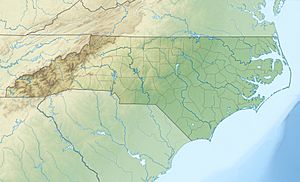Green River (North Carolina) facts for kids
Quick facts for kids Green River |
|
|---|---|

Upper Green River during low flow below Lake Summit, North Carolina
|
|
|
Location of Green River mouth
|
|
| Other name(s) | Tributary to Broad River |
| Country | United States |
| State | North Carolina |
| Counties | Henderson Polk Rutherford |
| Physical characteristics | |
| Main source | divide between Green River and French Broad River about 0.25 miles east of Green River Gap 2,720 ft (830 m) 35°09′47″N 082°35′06″W / 35.16306°N 82.58500°W |
| River mouth | Broad River about 0.5 miles upstream of Pores Ford Bridge 720 ft (220 m) 35°15′29″N 081°58′10″W / 35.25806°N 81.96944°W |
| Length | 58.2 mi (93.7 km) |
| Basin features | |
| Progression | northeast then southeast |
| River system | Broad River |
| Basin size | 241.02 square miles (624.2 km2) |
| Tributaries |
|
| Waterbodies | Lake Summit Lake Adger |
The Green River is a cool river in the mountains of North Carolina, south of Asheville. It gets its water from many smaller streams. A big part of its water comes from Big Hungry Creek. The Green River eventually flows into the bigger Broad River.
Dams on the river create two lakes: Lake Summit near Tuxedo, North Carolina, and Lake Adger near Mill Spring, NC. It's called "Green River" because it often looks deep green. But after heavy rains, it can turn brown.
Contents
River Landscape and Climate
The Green River starts in the Blue Ridge Mountains of North Carolina. It then flows through a steep area called the Blue Ridge Escarpment into the Piedmont region. The river's path is mostly made of strong, special kinds of rock, not soft dirt.
The area has a warm, wet climate, which means mild winters. It gets a lot of rain, usually about 100 to 140 centimeters each year.
Amazing River Life
The land around the Green River is a deciduous forest. This means trees lose their leaves in the fall. This area is known for having many different kinds of plants and animals. It has one of the highest numbers of different species in the eastern United States.
The Green River basin is like many mountain streams in the southeastern U.S. It is home to many animals, including deer and black bears. Some common trees you'll see are Maple, Birch, and Oak trees. The Green River gives fresh water to its ecosystem. It also provides food for many animals that live there.
Fishing Fun
Many people love to fish in the slower parts of the lower Green River. They come here for the freshwater trout. The Green River is also famous for some record-breaking fish! In 2018, the world record V-lip redhorse was caught here. Another world record, the notchlip redhorse, was also caught in the Green River that same year by a different angler.
In 2001, the North Carolina State record for Muskellunge was caught in Lake Adger. It weighed 41 pounds and 8 ounces!
Whitewater Adventures
The Green River is very popular for different whitewater sports. These include whitewater kayaking, canoeing, and tubing. Because the water flow is controlled by dams, the river usually has enough water for these sports about 300 days a year. This means people can enjoy whitewater fun here even when other rivers, like the Chattooga River or Nantahala River, don't have enough water.
The Green River has three main sections:
- The Upper Green
- The "Narrows" section
- The Lower Green
Each section is connected but has its own unique features. Different parts of the river attract different types of boating.
Upper Green River
This part of the Green River is often used by kayakers and people in whitewater canoes. It's about 3.7 miles long. The river drops about 49 feet for every mile.
This section starts below the Tuxedo Hydro Station, which controls the water flow. It ends where the "Narrows" section begins. Many whitewater paddlers use the Upper Green to get to the Narrows. It has only two major rapids that are considered moderately difficult (Class III). This section of the Green is narrow and feels more like a creek than a wide river. The way the water moves here makes it a great spot for playboating, which is a fun style of whitewater kayaking.
The Narrows Section
The "Narrows" part of the Green River is like a steep creek with drops between calm pools. It's very different from many wide, slow rivers in the southeast. This section is known for being "boulder congested" with a "pool-drop character."
This part of the river is extremely difficult for whitewater sports. It has nine Class IV rapids and eight Class V rapids. Class V rapids are the most challenging ones you can run. The first time someone successfully went down the Narrows was in 1988. Today, only very experienced whitewater boaters should try to paddle here. They need to know a lot about boating techniques.
Three of the biggest and most famous Class V rapids in this section are called the "Big Three." They are "Go Left and Die" (Class 5.1), "Gorilla" (Class 5.2), and "Sunshine" (Class 5.2).
This challenging section of water is home to the Green River Race. This race happens every year on the first Saturday of November. Many different types of boats compete. The race includes a timed section and a head-to-head part. Many paddlers think the Green River Narrows race is the most important whitewater racing event in the southeast.
The Narrows are special because the river drops over 100 feet for every mile. The whole section is about 3 miles long.
Lower Green River
This part of the river is popular with both kayakers and people who like to go tubing. Many local companies offer tubing trips here. They say it's a "safe" way to enjoy the whitewater. This entire section is considered a Class II section of water. This means it's good for people who are just starting out with whitewater sports. The Lower Green River is very calm compared to the other sections. It is about six miles long.
River Bridges
- Peter Guice Memorial Bridge (I-26)


